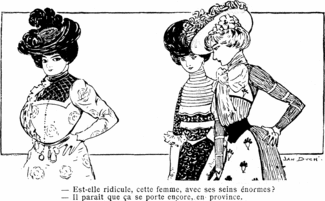Micromastia
| Micromastia | |
|---|---|
 | |
| Some societies idealize underdeveloped breasts, such as early-twentieth-century France. In this 1900 French cartoon, two small-breasted women criticize a large-breasted woman for not conforming to this fashion. | |
| Specialty | Medical genetics |
Micromastia (also called hypomastia, breast aplasia, breast hypoplasia, or mammary hypoplasia) is a medical term describing the postpubertal underdevelopment of a woman's breast tissue.[1] Just as it is impossible to define 'normal' breast size, there is no objective definition of micromastia. Breast development is commonly asymmetric and one or both breasts may be small. This condition may be a congenital defect associated with underlying abnormalities of the pectoral muscle (as in Poland's syndrome[2]), related to trauma (typically surgery or radiotherapy) or it may be a more subjective aesthetic description.
Self perceived micromastia involves a discrepancy between a person's body image, and her internalized images of appropriate or desirable breast size and shape. Societal ideals over breast size vary over time, but there exist many conceived ideas involving breasts and sexual attractiveness and identity across different cultures.
Causes
Micromastia can be congenital or acquired disorder and may be unilateral or bilateral.[3] Congenital causes include ulnar–mammary syndrome (caused by mutations in the TBX3 gene), Poland syndrome, Turner syndrome, and congenital adrenal hyperplasia.[3] There is also a case report of familial hypoplasia of the nipples and athelia associated with mammary hypoplasia that was described in a father and his daughters.[3] Acquired causes of micromastia include irradiation in infancy and childhood and surgical removal of prepubertal breast bud.[3]
Treatment
The procedure to remedy micromastia is breast enlargement, most commonly augmentation mammoplasty using breast implants. Other techniques available involve using muscle flap-based reconstructive surgery techniques (latissimus dorsi and rectus abdominis muscles), microsurgical reconstruction, or fat grafting.
Another potential treatment is hormonal breast enhancement, such as with estrogens.[4][5][6]
See also
References
- ↑ eMedicine - Breast Augmentation, Subglandular : Article by Howard T Bellin.
- ↑ Poland, Alfred (1841). "Deficiency of the pectoral muscles". Guy's Hospital Reports. VI: 191–193.
- 1 2 3 4 Syed A. Hoda; Edi Brogi; Fred Koerner; Paul Peter Rosen (5 February 2014). Rosen's Breast Pathology. Wolters Kluwer Health. pp. 149–. ISBN 978-1-4698-7070-0.
- ↑ Gunther Göretzlehner; Christian Lauritzen; Thomas Römer; Winfried Rossmanith (1 January 2012). Praktische Hormontherapie in der Gynäkologie. Walter de Gruyter. pp. 385–. ISBN 978-3-11-024568-4.
- ↑ R.E. Mansel; Oystein Fodstad; Wen G. Jiang (14 June 2007). Metastasis of Breast Cancer. Springer Science & Business Media. pp. 217–. ISBN 978-1-4020-5866-0.
- ↑ Hartmann BW, Laml T, Kirchengast S, Albrecht AE, Huber JC (1998). "Hormonal breast augmentation: prognostic relevance of insulin-like growth factor-I". Gynecol. Endocrinol. 12 (2): 123–7. doi:10.3109/09513599809024960. PMID 9610425.